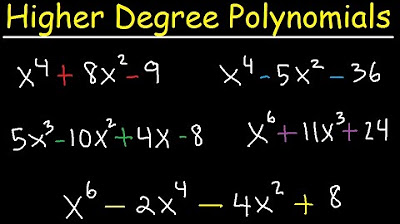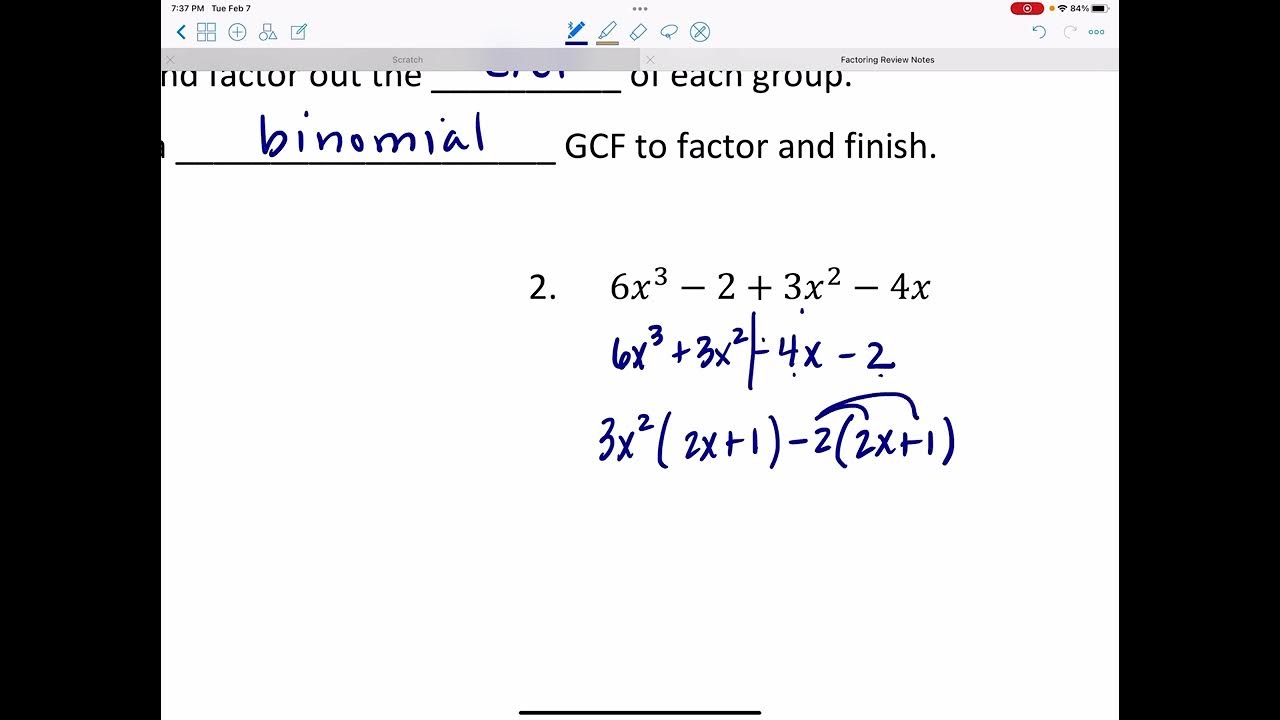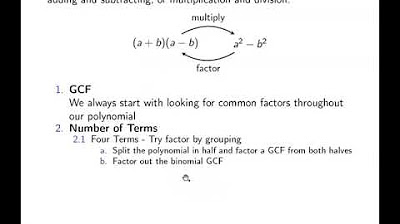AP Calculus AB - 1.6a Review of Expanding and Factoring Techniques
TLDRThis video script covers the topic of 'Determining Limits using Algebraic Manipulation' in AP Calculus AB Unit 1. It begins with a review of polynomial and quadratic expansion and factoring techniques, including FOIL, expansion boxes, and GCFs. The script then delves into specific factoring methods such as the difference of squares, the 'big x' method, and factoring by grouping. The instructor emphasizes the importance of these algebraic skills for calculus, provides step-by-step examples, and encourages practice, especially ahead of the SATs.
Takeaways
- 📚 The lesson is a continuation of AP Calculus AB, focusing on Unit 1 Limits and Continuity, specifically Topic 1.6 on determining limits using algebraic manipulation.
- 🔍 The session is divided into two parts, with the current one being Part A, which reviews polynomial and quadratic expansion and factoring techniques.
- 📝 The instructor emphasizes the importance of reviewing algebraic manipulation methods, as they are crucial for understanding calculus concepts.
- 📐 The script introduces two common methods for expanding expressions: the FOIL method and the Expansion Box method, providing examples for each.
- 🔢 The FOIL method (First, Outside, Inside, Last) is a mnemonic for remembering the order of multiplication when expanding binomials.
- 📦 The Expansion Box method visually organizes the multiplication process, leading to the same result as the FOIL method but with a different approach.
- 🌟 The instructor stresses the utility of expanding factored terms in calculus, suggesting that students should practice this skill.
- 🔑 The lesson reviews factoring techniques, starting with finding the Greatest Common Factor (GCF), which simplifies the factoring process.
- 🔍 The Difference of Two Squares technique is highlighted as a common and useful method for factoring expressions of the form a^2 - b^2.
- 📈 The 'x' method, or Big X method, is introduced for factoring quadratic trinomials when the leading coefficient (a) is one.
- 📘 Factoring by grouping is presented as a technique for factoring expressions with more than three terms, similar to the Big X method but applicable to larger polynomials.
- 🔄 The script encourages students to practice these techniques, especially before the SAT, and to seek additional help if needed.
Q & A
What is the main topic of the video script?
-The main topic of the video script is determining limits using algebraic manipulation in the context of AP Calculus AB Unit 1.
What are the two parts of the lesson on determining limits using algebraic manipulation?
-The lesson is divided into two parts: Part A, which is covered in the script, and a second part that will be covered in a subsequent lesson.
Why is it important to review expanding and factoring polynomials and quadratics before starting the lesson?
-It is important to review expanding and factoring polynomials and quadratics because these skills are essential for understanding and applying algebraic manipulation in calculus, and it has been some time since these topics were last covered.
What does FOIL stand for and how is it used in the script?
-FOIL stands for First, Outside, Inside, Last. It is a method used to remember the order of multiplication when expanding two binomials, as demonstrated in the script with the example of (2x - 3)(3x + 4).
How is the 'expansion box' method different from the FOIL method?
-The 'expansion box' method involves writing out the factors and systematically multiplying each term, similar to the FOIL method, but it visually organizes the multiplication in a box format, making it easier for some students to follow the process.
What is the first step in factoring polynomials according to the script?
-The first step in factoring polynomials is to always look for the Greatest Common Factor (GCF) of the terms.
Can you provide an example of how to use the Greatest Common Factor (GCF) in factoring?
-An example given in the script is factoring 21x^3 + 7x^2 by taking out the GCF, which is 7, resulting in 7x^2(3x + 1).
What is the 'Difference of Two Squares' factoring technique and how is it applied?
-The 'Difference of Two Squares' is a factoring technique where a^2 - b^2 can be factored into (a + b)(a - b). It is applied when there is a subtraction between two squared terms, as shown in the script with the example of x^2 - 49 factoring into (x + 7)(x - 7).
What is the 'x method' or 'big x method' for factoring quadratics?
-The 'x method' or 'big x method' is a technique for factoring quadratics of the form ax^2 + bx + c by finding two numbers that multiply to ac and add up to b, then factoring the quadratic into (x - p)(x - q) where p and q are those two numbers.
How does the script suggest checking the correctness of factored forms?
-The script suggests checking the correctness of factored forms by re-expanding them to see if they match the original expression.
What is the purpose of the review of expanding and factoring techniques in the script?
-The purpose of the review is to ensure students have a solid understanding of these techniques before moving on to more advanced topics in calculus, and to provide a refresher before potentially upcoming exams like the SAT.
Outlines
📚 Review of Polynomial Expansion and Factoring Techniques
The instructor begins by introducing the topic of limits and continuity in AP Calculus AB, focusing on algebraic manipulation. They review the importance of expanding and factoring polynomials and quadratics, especially since it's been some time since students last encountered these concepts. The summary includes two common methods for expansion: the FOIL method and the expansion box technique. The instructor demonstrates both methods using the example of (2x - 3)(3x + 4), emphasizing the need to combine like terms. They encourage students to practice these techniques, as they will be useful in calculus.
🔍 Factoring Techniques and the Greatest Common Factor
The second paragraph delves into factoring techniques, starting with identifying the greatest common factor (GCF) in expressions like 21x^3 + 7x^2, where 7 is the GCF. The instructor shows how to factor by grouping and using the difference of squares technique, which applies to expressions of the form a^2 - b^2. Examples are given to illustrate the process, such as factoring x^2 - 49 into (x + 7)(x - 7). The summary highlights the importance of recognizing when to apply these techniques and the need for practice to ensure mastery.
📈 The X Method for Factoring Quadratic Trinomials
In the third paragraph, the instructor introduces the X method, or big X method, for factoring quadratic trinomials of the form ax^2 + bx + c. The method involves creating a large X and filling in the values of a*c at the top and b at the bottom, then finding two numbers that multiply to a*c and add up to b. The summary provides a step-by-step guide on how to apply the X method, including an example with x^2 - 7x + 12, and explains the shortcut version of the method when a = 1. The instructor also addresses a more complex example where a ≠ 1, demonstrating the full version of the X method involving GCFs and factoring by grouping.
📝 Advanced Factoring Techniques and Grouping
The final paragraph continues the discussion on factoring, focusing on more complex polynomials that are not quadratic. The instructor demonstrates factoring by grouping with the example of x^3 - x^2 + 2x - 2, showing how to factor out common terms from pairs of terms. They also review the process of checking the factored form against the original expression to ensure correctness. The summary emphasizes the importance of recognizing patterns in polynomials and applying appropriate factoring techniques, including the use of the X method for quadratics and grouping for higher-degree polynomials.
Mindmap
Keywords
💡Algebraic Manipulation
💡FOIL
💡Expansion Box
💡Factoring
💡Greatest Common Factor (GCF)
💡Difference of Squares
💡X Method
💡Factoring by Grouping
💡Polynomials
💡Quadratics
Highlights
Continuation of AP Calculus AB Unit 1 on limits and continuity.
Introduction to topic 1.6 on determining limits using algebraic manipulation, in two parts.
Review of expanding and factoring polynomials and quadratics.
Explanation of the FOIL method for expanding expressions.
Use of an 'expansion box' for a visual approach to expanding expressions.
Importance of combining like terms after expansion.
Emphasis on the utility of expansion in calculus for factored terms.
Review of factoring techniques, starting with looking for the greatest common factor (GCF).
Application of the difference of two squares factoring rule.
Use of the 'x method' or 'big x method' for factoring quadratic trinomials.
Explanation of the shortcut method for the 'x method' when 'a' equals one.
Demonstration of factoring when 'a' is not one, using GCF and grouping.
Introduction to factoring by grouping for larger term polynomials.
Technique of splitting terms and factoring using GCF for non-quadratic polynomials.
Final review of factoring and expanding techniques with practical examples.
Assignment of practice problems on DeltaMath for students to apply the reviewed concepts.
Encouragement for students to attend class for additional examples and questions.
Hope expressed for the review to be beneficial before the SAT.
Transcripts
Browse More Related Video

Factoring Higher Degree Polynomial Functions & Equations - Algebra 2

AP Calculus AB - 1.6b Determining Limits Using Algebraic Manipulation

Factoring Review

AP Calculus AB - 1.7 Selecting Procedures for Determining Limits

Factoring Polynomials - By GCF, AC Method, Grouping, Substitution, Sum & Difference of Cubes

Ch. 1.3 Algebraic Expressions
5.0 / 5 (0 votes)
Thanks for rating: